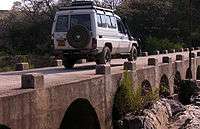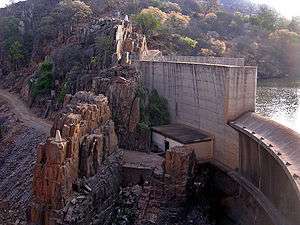Thuli River
The Thuli River, former name Tuli River, is a major tributary of the Shashe River in Zimbabwe. It rises near Matopo Mission, Matobo District, and flows into the Shashe River near Tuli village.
| Thuli River | |
|---|---|
 | |
| Location | |
| Country | Zimbabwe |
| Physical characteristics | |
| Source | |
| • location | Matopo Mission, Matobo District, Zimbabwe |
| Mouth | |
• location | Shashe River |
| Basin size | 7,910 km2 (3,050 sq mi) |
| Discharge | |
| • average | 36.0 mm/a (1.42 in/year) unit flow[1] |
Hydrology
The Thuli is an ephemeral river, with declining annual unit runoff.[2]
Major tributaries of the Thuli River include the Mtshabezi, Mtshelele, Sengezane river and Mwewe Rivers.
The Thuli River below Thuli-Makwe Dam is a sand filled channel, with alluvial aquifers in the river channel.[3]
Towns along the river
The Thuli River passes through no major settlements, only the following business centres:
- Freda Mine
- Guyu
- Manama
- Chelesa, Zimbabwe [Sengezane]
Bridges and crossings

There are five main bridges over the Mzingwane River:
- Bridge on Old Gwanda Road, between Matombo Mission and Blanket Mine.
- Bridge on Gwanda - Kezi road, below Thuli-Makwe Dam.
- Elliot Bridge, upstream of Guyu.
- Bridge on Manama - Kafusi road.
- Mankonkoni Bridge on Tuli - Kafusi road. This bridge was destroyed by Cyclone Eline.
There are also a number of fords and crossing points, including:
- Ntalale causeway, which was badly damaged by Cyclone Eline.
- Causeway below Thuli gorge
Development

In addition to a number of small weirs, there is one major dam on the Thuli River:
- Thuli–Makwe Dam, west of Gwanda. It is located near the confluence with the Mtshelele River and supplies water for irrigation.
The Mtshabezi River (the principal left-bank tributary) is dammed at Mtshabezi, Sheet and Blanket. Mtshabezi Dam will augment the water supply for the City of Bulawayo, once a connecting pipeline has been completed. Sheet and Blanket Dams supply water to the City of Gwanda and Blanket and Vubachikwe Mines.
Two additional dam sites have been selected further downstream:
- Thuli–Moswa, where no development has taken place.
- Thuli–Manyange, upstream of Elliot Bridge, where construction was briefly started in 2007 but is now halted.[1]
References
| Wikimedia Commons has media related to Thuli River. |
- Chibi, T., Kandori, C. and Makone, B.F. 2005. Mzingwane Catchment Outline Plan. Zimbabwe National Water Authority, Bulawayo.
- Love, D., Uhlenbrook, S., Madamombe, E., Twomlow, S. and van der Zaag, P. 2006. An evaluation of climate and run-off variability and associated livelihood risks in the Mzingwane Catchment, Limpopo Basin, Zimbabwe. Water Institute of Southern Africa Biennial Conference and Exhibition, Durban, South Africa, May 2006.
- Görgens, A.H.M. and Boroto, R.A. 1997. Limpopo River: flow balance anomalies, surprises and implications for integrated water resources management. In: Proceedings of the 8th South African National Hydrology Symposium, Pretoria, South Africa.